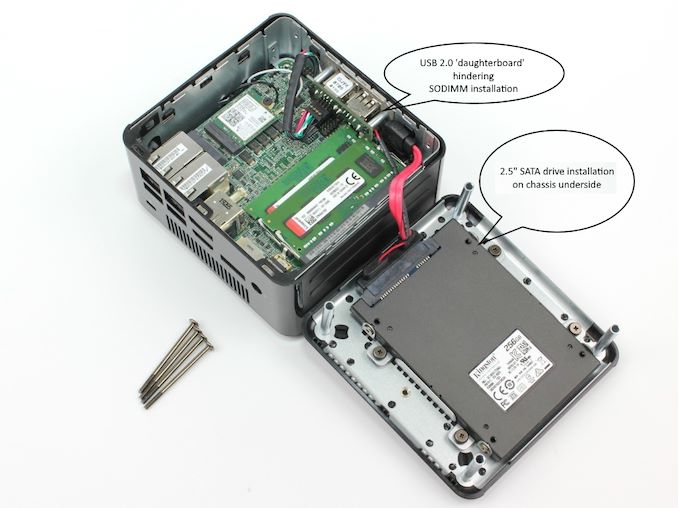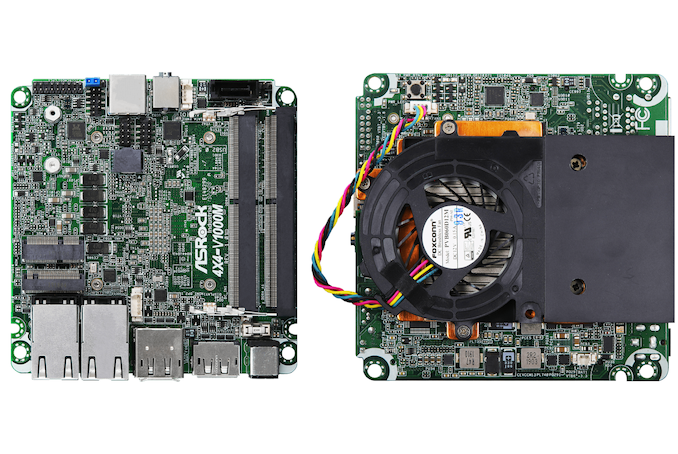ASRock Industrial 4X4 BOX-V1000M Ryzen Mini-PC Review: Finding Zen In The Small Things
by Ganesh T S on September 28, 2020 8:00 AM EST- Posted in
- Systems
- AMD
- NUC
- UCFF
- Ryzen
- Ryzen Embedded
- ASRock Industrial
Hardware Setup and Platform Analysis
The internal components of the 4X4 BOX-V1000M are packed densely together. The front panel's two USB 2.0 ports are enabled by a daughterboard connecting to the motherboard's USB 2.0 headers. The mounting for this daughterboard, and the SATA port / cable location make the installation of the DDR4 SODIMMs a challenging process. In fact, based on my experience, it is better to completely take out the daughterboard prior to the SODIMM installation process. Installing a 2.5" drive is fortunately not as painful, as it is similar to the installation process in the tall NUCs from Intel, and the SATA cable is already in place inside the chassis.

(Annotation on photograph sourced from Hermitage Akihabara)
The rest of the internal components are the usual suspects in a NUC targeting industrial applications - a Realtek ALC233 audio codec, an Exar SP339E serial port transceiver, and a couple of Raltek RTL8111G gigabit Ethernet controllers on one side, and a 60mm fan on top of a copper heat sink on the other side.
Once the build components were in place, it was a fairly uneventful process to complete the OS installation. The UEFI BIOS of the 4X4 BOX-V1000M is quite basic - consumers used to ASRock's fancy GUI and plethora of value additions are bound to be disappointed with the spartan AMI BIOS interface in this ASRock Industrial system. The gallery below shows the various available BIOS options.
The block diagram of the Ryzen Embedded V-Series SoC is presented below.
The V1605B specifically provides:
- 2x 10GbE
- 1x USB 2.0
- 1x USB 3.1 Gen1
- 4x USB 3.1 Gen2
- 2x SATA III
The 4X4 BOX-V1000M does not use the 10GbE interfaces. It also uses the single USB 2.0 port of the SoC to drive a header on the board that enables a daughterboard downstream to provide 2x USB 2.0 ports in the front panel. The USB 3.2 Gen 1 port and one of the USB 3.1 Gen 2 ports of the SoC are left unused. Networking support is provided using PCIe lanes.
The AIDA64 system report for our 4X4 BOX-V1000M configuration provides a breakdown of the usage of the PCIe lanes and adds additional context to the above block diagram:
- PCIe 3.0 x4 and a SATA port multiplexed behind the M.2 2242/2260 slot
- PCIe 3.0 x1 for the Intel Wireless-AC AC3168 WLAN card
- PCIe 3.0 x1 for the Realtek RTL8111G #1
- PCIe 3.0 x1 for the Realtek RTL8111G #2
The absence of a discrete PCH means that there is no 'DMI bottleneck' at play in the SoC. Another interesting aspect is the support for four simultaneous 4Kp60 display outputs from the V1605B. The 4X4 BOX-V1000 only supports three, though, with two DP 1.2a ports and a HDMI 2.0a port.
In the remainder of this review, we will first look at various UL benchmarks, followed by miscellaneous workloads. A detailed look at the HTPC credentials of the system is followed by testing of the power consumption and thermal solution. In our recent system reviews, we have usually started off with BAPCo's SYSmark 2018 - unfortunately, we ran into some showstopper issues with the 4X4 BOX-V1000M review configuration, as the benchmark program consistently errored out (mostly during the Photoshop CC workload component). We had seen similar problems in previous AMD-based PCs that ended up getting resolved with driver updates, but we had no such luck with this system. Incidentally, with the same GPU drivers, we were able to get the workload processed correctly on an ECS LIVA A320 sporting an AMD Athlon 3000G processor. Debugging the issue on the 4X4 BOX-V1000M beyond a few attempts was beyond the scope of this review. Hence, we decided to drop the attempt to publish SYSmark 2018 numbers for the 4x4 BOX-V1000M.


















37 Comments
View All Comments
nagi603 - Monday, September 28, 2020 - link
I wish those were intel NICs instead of Realtek, but you can't win all.webdoctors - Monday, September 28, 2020 - link
Love the title, haha.I like the TDP specs of this as I built a low power home nas machine for storing surveillance videos and home automation scripts. But the pricing on this is TERRIBLE. I built a tiny SFF machine for ~$130! It was like $60 for the mobo+CPU, $50 case+PS, $20 RAM etc.
What niche is this thing trying to fulfill?
eastcoast_pete - Monday, September 28, 2020 - link
Thanks for the review, although I would have really liked to see a review of that unit with the 4800u Renoir chip. The long-term support of this unit is, of course, interesting if one deploys them in actual "industrial" settings. However, I strongly assume that most readers here would use a small format PC like this as HTPC at home, and would gladly trade the superior performance of an 8 core Renoir for the "long-term support". So, any chance of seeing that review here?GreenReaper - Monday, September 28, 2020 - link
Why doesn't it use the 10GbE provided by the CPU, even at 1Gbps? Is it a question of power usage? Cost of transceivers? Reliability?eastcoast_pete - Monday, September 28, 2020 - link
10 GbE requires additional hardware (e.g. from Aquantia, or others); the situation is similar for many Intel-based systems. A number of current CPUs are capable of supporting 10 GbE, but all need the additional hardware. In contrast, 2.5 GbE can be implemented w/o adding much to the BOM, so more systems now ship with 2.5 GbE instead of just 1 GbE.GreenReaper - Monday, September 28, 2020 - link
Also, AMD is playing silly buggers with links to its specifications; the one in the article on the model number just leads to a menu page for me. This link has a V1000-series product brief:https://www.amd.com/en/media/42701/download
nicolaim - Monday, September 28, 2020 - link
No USB-C ports on something that's supposed to last up to ten years?PyroHoltz - Monday, September 28, 2020 - link
Good point. Maybe asrock knows something that we don't and usb-c is going to be replaced in the next 5?Lord of the Bored - Wednesday, September 30, 2020 - link
I doubt the target market is going to be plugging any USB-C... whatevers. I think the only things that actually ship with a USB-C connectors are laptop "docks" and USB-grownup-connector adapters.There's literally no benefit to USB-C in this segment.
PeterEvans - Monday, September 28, 2020 - link
Well I guess this is one way to get rid of the three year old laptop parts. Just put them together into a shoebox and call it "innovative". I am surprised it doesn't come with Windows XP.